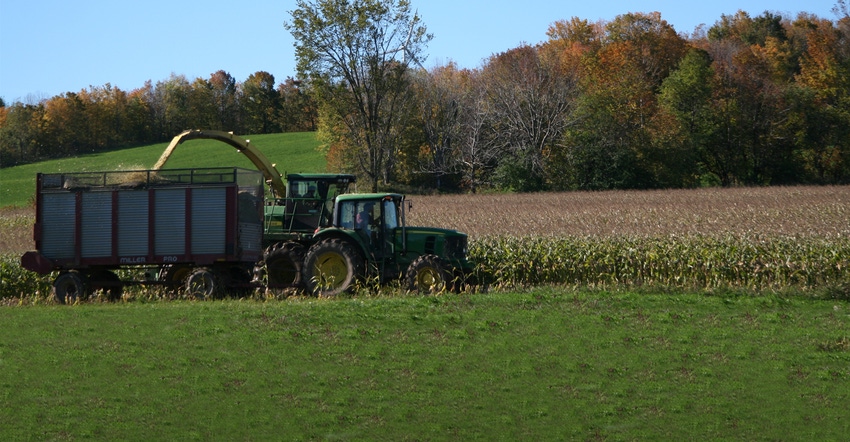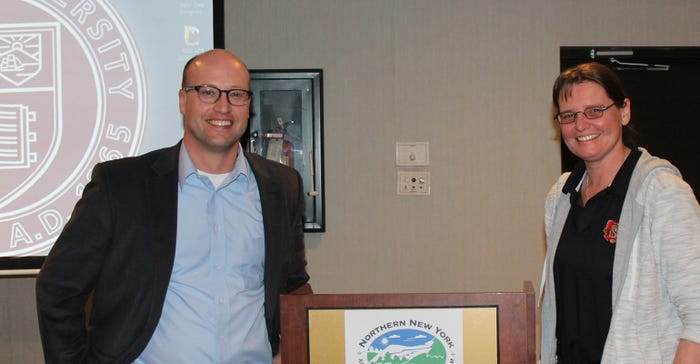October 30, 2018

By Paul Post
Quirine M. Ketterings, director of the Nutrient Management Spear Program at Cornell University, is heading up a yield-based zone management project designed to improve decision making for manure and fertilizer use, seed density, and crop variety in New York state.
Corn data being collected from yield monitors on harvesting equipment is now being complemented by drones in the sky and satellite imagery.
"Economics is important, but it’s really being driven by the availability of this technology," she says. "The main reason for doing it is the desire to move forward with field management."
New Focus on yield stability
Yield monitors on grain harvesting equipment have been in use for quite some time. Thanks to improved technology, they provide valuable data about moisture content, biomass and yield from specific field locations. Such information becomes very detailed when complemented by drones and satellite imagery.
"What we’re zeroing in on is not just relative yield this year versus last year, but actual yield stability over time," she says. "That’s the focus, that’s what is unique here. Some areas always have high, low or variable yield. The key is identifying them and taking steps to improve low or variable areas to achieve yield stability."
The main goals of zone-based management are reduced production costs, higher corn yield and quality, and improved environmental practices by pinpointing areas where nutrients may not be needed, or are needed in lesser amounts.
This is the first year of a project that’s expected to last three years.
"We’ll spend the winter months trying to make sense of data and should be able to share some information next spring," she says. "It will be very preliminary. This type of work you don’t do in a year.
"With yield data of three or more years for a field, a map can be created with four zones," she says. "This mapping allows us to evaluate where to invest limited resources."
The Farm Viability Institute is funding similar research on farms across in the state. Assistant professor Erasmus K. Oware of the University at Buffalo’s Geology Department, who has done extensive zone management and soil mapping work, is a key contributor to the project, too.
"This is a multiorganization collaboration," Ketterings says.
Managing more nutrients
The 1,400-cow Greenwood Dairy in Potsdam is hosting research funded by the Northern New York Agricultural Development Program.
"There’s really two parts," says Jon Greenwood, farm owner and program co-chairman. "First is taking yield data and comparing it to soil types. If there’s a lower-yielding spot, you want to know why. There might be a need for drainage, or is it just soil type? For example, there might be an area where you took out hedgerows and removed a lot of topsoil.
"With the use of variable-rate planters and fertilizer spreaders it will allow you to micromanage your fields."
Yield potential for some soil types was established quite some time ago. In some cases, yields are higher than originally thought, so the project also seeks to update such data.
"If you’re a CAFO (concentrated animal feeding operation) farm, the amount of nutrients you can use is governed by soil yield potential," he says. "This really is about verifying the data we’ve got. Nobody wants to apply more nutrients than are needed."
A second component of the project is applying nitrogen in test strips to see if there’s a yield response. A higher yield would support the need for more widespread use of nitrogen the next year. But if plants don’t respond, there’s no need for increased applications.
"That would definitely have a bottom-line financial impact," he says. "If you don’t need it, why apply it?"
Expanding zone mapping
The current focus of zone mapping is on nitrogen management, but Ketterings says this zone-management approach can be expanded to other nutrients, manure application methods, tillage decisions, variety selection, population densities and foliar applications.
"Boots-on-the-ground" experience is still a valuable part of good field management, Greenwood says. "You have to combine what the research is showing you, plus what the farmer knows about the field."
 PROJECT LEADERS: Quirine Ketterings, right, director of the Nutrient Management Spear Program at Cornell, and Eric O. Young, soil scientist at Miner Institute, are leading a three-year project to help farmers make better decisions regarding fertilizer use, manure management, seed density and crop variety.
PROJECT LEADERS: Quirine Ketterings, right, director of the Nutrient Management Spear Program at Cornell, and Eric O. Young, soil scientist at Miner Institute, are leading a three-year project to help farmers make better decisions regarding fertilizer use, manure management, seed density and crop variety.

This is one of the reasons for doing research at multiple locations.
"Farmer participation is essential to identifying yield limitations and developing strategies that make best use of resources like manure and fertilizer," Ketterings says. "Our goal is to find ways to improve yield and nutrient use, and reduce the risk of nutrient loss to the environment at the same time. It’s very promising. But we first need to make sense of all the information."
New tool to manage nutrients
In a separate but related project, Ketterings is spearheading a project where North Country farmers are using a whole-farm nutrient mass balance software to identify places for improving their use of nitrogen, phosphorus and potassium. The goal is to enhance watershed and agricultural stewardship while increasing on-farm efficiency, milk production and crop yield.
This, too, is funded by the Northern New York Agricultural Development Program.
The software allows farmers to compare the nutrient imports brought onto the farm in feed, fertilizer, animals and bedding with the amount of nutrients exported off the farm as milk, crops, animals and manure. The difference is the farm balance that can be presented as a plus or minus balance per acre of cropland or per hundredweight of milk produced.
Farms participating in an assessment of the software statewide have adjusted management practices over the past decade, which has resulted in a 25% to 30% reduction in the import of nitrogen and phosphorus without a decrease in milk production.
Post writes from eastern New York.
You May Also Like




